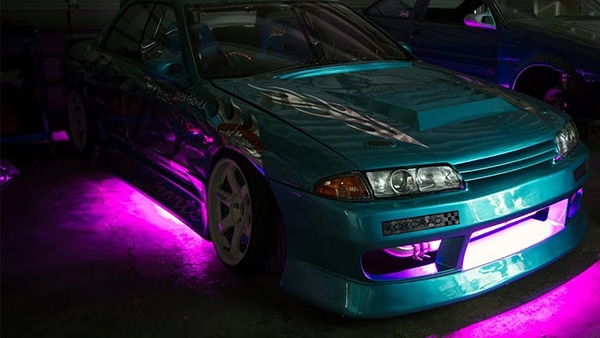Also known as underglow lights, neon car lights are either non-standard neon tubes or LED lights that are attached under the chassis of a truck, car or motorcycle and are a popular way to enhance the looks of the vehicle.
Some motorists, especially bikers, believe that underglow lights offer enhanced safety, especially at night. But in general, underglow lighting creates a nice, halo effect and makes your vehicle look cool.
But different states in the U.S. have different laws regarding the use of neon underglow lights, which are covered by the motor vehicle codes or traffic laws of the state. So, is underglow legal in Vermont? Continue reading to find out.
Vermont Laws for Underglow Lights

The use of neon underglow lighting in the state is governed by the Vermont Statutes, Title 23: Motor Vehicles, Chapter 13 which provides all the rules and regulations regarding car underglow lighting.
Also, before you install any neon underglow lighting on your vehicle, it is a good idea to know and understand these rules so that you don’t end up with any restricted or prohibited lights.
Light Type and Size
The state underglow laws do not specify the type of underglow lighting that can be used on vehicles.
There are no specifications or restrictions on the size of the lights that can be used as underglow lighting on vehicles.
Permitted Colors and Intensity
Underglow is permitted in Vermont, but prohibits the use of blue, red or amber underglow. Also, the license plate of the vehicle must be illuminated in white.
Underglow lighting should not produce more than 4 candlepower and you can only use low-emission neon or LED lights.
So before installing the lights on your vehicle, it is recommended to check the neon or LED light packaging and tech specs.
Are Underglow Neon Lights Legal in Vermont?
Driving with underglow lights is legal in Vermont. However, there are some specifications regarding other types of aftermarket lights that must be followed, including:
- According to section 1243 of the Code, you cannot use any lighting of more than 4 candlepower that features a reflector 30 minutes before sunrise and 30 minutes post sunset, unless the lens and candlepower are approved by the Commissioner of Motor Vehicles.
- Or, unless the light is designed, arranged or deflected so that the reflected light beam does not rise over 6″ from the height of the bulb when measured from a distance of 75 feet or more from the lamp. The beam must not be more than 42″ from the surface on which the vehicle is standing.
- Any tail lamp or separate lamp installed at the rear of the vehicle should illuminate the registration plate in white light.
- Use of blue and white signal lamps, blue lights, sirens, or a combination of all these can only be used by law enforcement vehicles.
- Use of red and white signal lamps or red lights and sirens can be used only by fire apparatus vehicles, ambulances and vehicles used in rescue operations.
- Amber-colored signal lamps may only be used by service vehicles, wreckers, road maintenance vehicles and snow removal vehicles.
- The Vermont DMV also states that a vehicle may not pass inspection under the following situations:
- If you use any aftermarket equipment in front of or on the lamp such as colored or smoked light covers. This excludes the original transparent covers that are provided on the headlamps by the manufacturer.
- Any aftermarket lamp that doesn’t have the letters DOT vertically or horizontally on the lens.
- Any flashing or steady aftermarket underglow lights that are placed underneath or in the vehicle.
- Any flashing or steady aftermarket license plate glow lights that are placed underneath or on the vehicle.
- Any aftermarket lamps not permitted by law such as blue, red or green lights.
- Any flashing or steadily burning aftermarket or auxiliary lights that are placed in or on the vehicle that do not enhance safety and are not approved Commissioner of Motor Vehicles.
State of Vermont Info

Situated in the New England region of the U.S., Vermont is the only state in New England that is not bordered by the Atlantic Ocean.
Vermont was discovered way back in the 1500s and was originally one of the 13 colonies. The area has been inhabited by indigenous people for over 12,000 years.
Vermont is the major producer of maple syrup in the country and is known for its stunning autumn foliage, ski resorts, cheese trails, and craft beer.
Population: 647,378
Capital: Montpelier
Registered vehicles: 607,890
Total lane miles: 29,273
Number of highways: 5
Underglow light law references:

